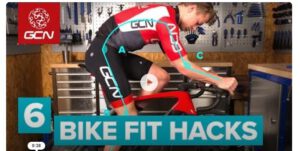Fietshouding door Marco Meuleman
Een belangrijk verschil tussen toeristen, hardrijders en triathlonners en echte wielrenners is te zien aan de houding op de fiets. Een goede houding resulteert in harder gaan zonder meer inspanning (efficiency), minder klachten, maar vooral (en eigenlijk alleen) is het van belang voor hoe u er uit ziet. En hoe u er uit ziet op de fiets, is voor een echte renner vrijwel het belangrijkste. Hieronder volgen een aantal voorbeelden en trucs om uw houding te verbeteren.
https://www.liv-cycling.com/global/campaigns/proper-body-position-on-a-road-bike/20716

PROPER BODY POSITION ON A ROAD BIKE
HOW TO RIDE WITH PROPER BODY POSITION ON A ROAD BIKE
Riding with a balanced and relaxed body position may seem like a basic skill for a road cyclist, but it is something that even experienced riders struggle with and can cause frustration for beginner roadies. After getting a professional bike fit, proper body position is usually the next thing we look at when diagnosing pain while riding. It may sound simple, but reminding yourself to relax your shoulders while out on a long ride or hard effort could save you from nasty neck pain the following day.
What is a Good Neutral Position on a Road Bike?
A good neutral riding position starts with the head and goes all the way to your feet. On long rides, check in occasionally with your body position to make sure you haven’t drifted back into bad habits.

- Relax your shoulders and bring them down, away from your ears. If you have been pushing hard on a climb, you may notice those shoulders stiffen and start to creep up again.
- Lowering your shoulders away from your ears will free up your head, making it easier to turn and look for traffic and actually helps you stay more alert!
- Bend your elbows! Just like on a mountain bike, riding with relaxed, bent elbows allows your arms to act like suspension. If you hit a pot hole or bump in the road, your arms can help you absorb impact. Unlike mountain bike body position, your elbows should be tucked into your sides instead of out wide like wings. Keeping your elbows bent will also reduce strain in your shoulders and allow you to ride with less pressure in your hands.
- There should not, however, be a bend in your wrists. Maintain a straight line from your elbow through your fingers on the brakes. If this is hard, it might be a bike setup issue you should discuss brake lever and hood position with your professional bike fitter.
- Maintain a neutral spine. What does that mean? Well, it’s kind of like yoga. If you are familiar with the Cat and Cow positions in yoga, either of those positions while in the saddle could cause pain down below and inefficiency on the bike. Your back should be relaxed, keeping a fairly straight line between your hips and your shoulders. The best way to check this position while you are riding is to ask yourself: Is my core engaged? If your abdominal muscles are taking a break while cycling, it could result in a slouched riding position that could put pressure on your hands, shoulders or parts of your crotch (eek)!
- Make sure your knee is tracking over the ball of your foot/pedal. If your knees are bowing out to the side when you ride, it may look a little funny and it will definitely cause inefficiency and pain.
When Do I Use the Drops?
One of the cool things about road bikes is there are three places to put your hands! The handlebars look that way on purpose because road bikes are meant to travel long distances with the rider in a pretty static position. Having multiple places to put your hands allows you to change body positions to use different muscle groups and change your center of gravity.
Drops are good for downhill! Although it may be a little scary at first, lowering your hands to the “drops” of the handlebar is ideal for descending on the road. By placing your hands lower on the bar, you are lowering your center of gravity and actually putting a little additional pressure on the front wheel. This will add traction and balance while riding downhill. You will also have a little better grip on the brakes!
The hoods are where you will ride most of the time. Riding in the hoods allows you to easily shift and reach the brakes while maintaining a relaxed riding position.
Only ride with your hands on the top of the bars for long, steady climbs without traffic. Unless you have access to brakes on the top of your bars, riding in this position is a little dangerous. However, during long, steady climbs this position can help you recover and breathe easier. It is not really a good idea to ride with your hands on top of the bars if you are in traffic or descending because you don’t have as much control over the bike, even if you have access to brakes.
My Hands are Going Numb When I Ride, Why?
We hear this all the time on group rides. You stop to take a sip of water, and your hands are numb. Why? Although this could be a bike fit issue, if you have determined the reach on your bike is acceptable, it may be a problem with your body position. Generally, your fingers and hands will go numb because they are not getting proper blood flow/circulation. So, check to make sure you are riding with relaxed, slightly bent elbows. Riding with your arms straight places a lot of weight in your hands and on your handlebars. Check your wrist alignment. If there is a bend in your wrist, this could prevent proper blood circulation in your hand. Engage your core! Reminding your abs to do a little work will definitely take some pressure off your hands!


